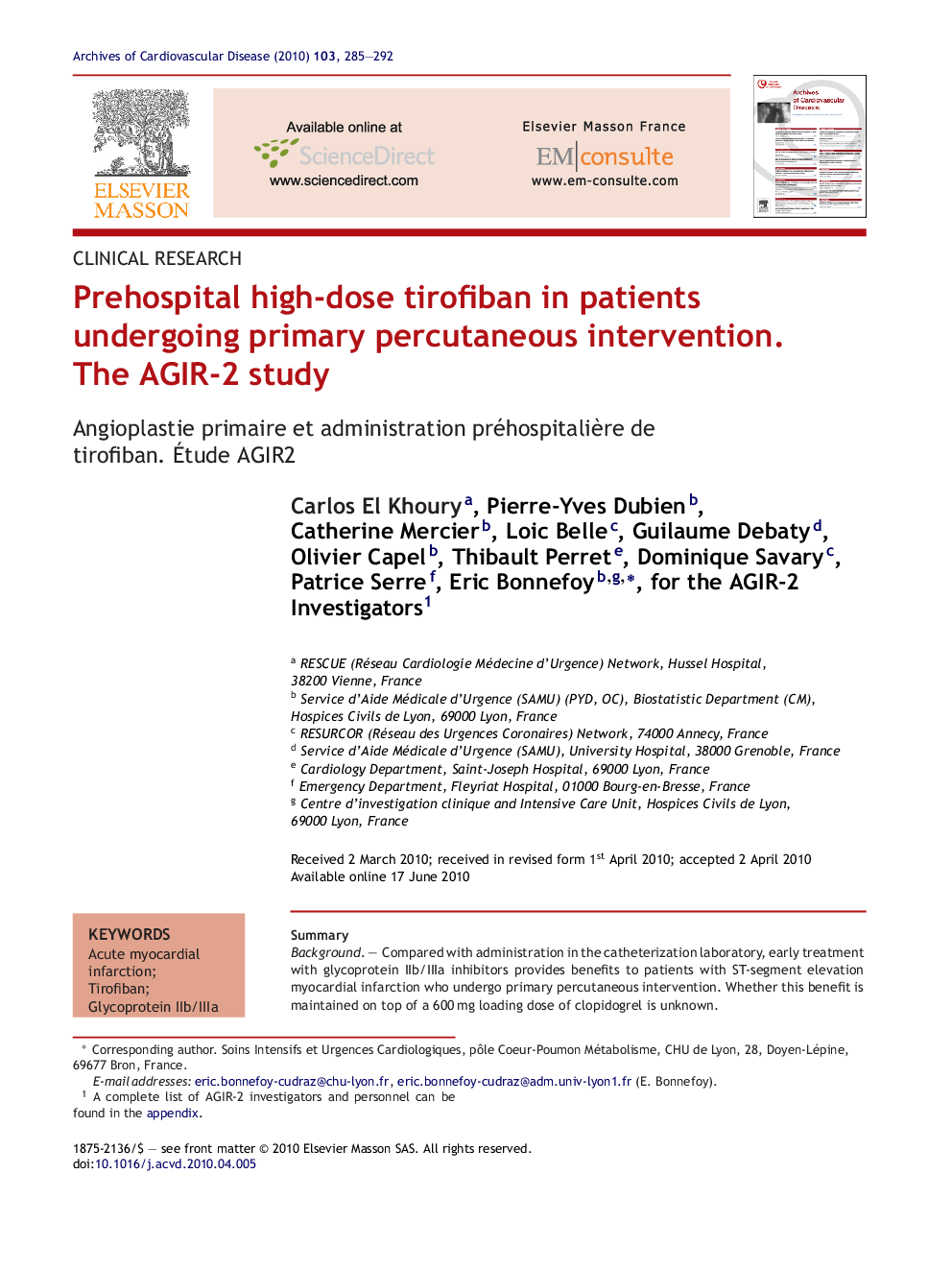| کد مقاله | کد نشریه | سال انتشار | مقاله انگلیسی | نسخه تمام متن |
|---|---|---|---|---|
| 2889839 | 1574393 | 2010 | 8 صفحه PDF | دانلود رایگان |

SummaryBackgroundCompared with administration in the catheterization laboratory, early treatment with glycoprotein IIb/IIIa inhibitors provides benefits to patients with ST-segment elevation myocardial infarction who undergo primary percutaneous intervention. Whether this benefit is maintained on top of a 600 mg loading dose of clopidogrel is unknown.MethodsIn a multicentre, controlled, randomized study, 320 patients with ST-segment elevation myocardial infarction undergoing primary percutaneous coronary intervention received a high-dose bolus of tirofiban given either in the ambulance (prehospital group) or in the catheterization laboratory. The primary endpoint was a TIMI flow grade 2–3 of the infarct-related vessel at initial angiography. Secondary endpoints included ST-segment resolution 1 h after percutaneous coronary intervention and peak serum troponin I concentration.ResultsTirofiban was administered 48 (95% confidence interval 21.4–75.0) min earlier in the prehospital group. At initial angiography, the combined incidence of TIMI 2–3 flow was 39.7% in the catheterization-laboratory group and 44.2% in the prehospital group (p = 0.45). No difference was found on postpercutaneous intervention angiography or peak troponin concentration. Complete ST-segment resolution 60 min after the start of intervention was 55.4% in the catheterization-laboratory group and 52.6% in the prehospital group (p = 0.32).ConclusionPrehospital initiation of high-dose bolus tirofiban did not improve significantly initial TIMI 2 or 3 flow of the infarct-related artery or complete ST-segment resolution after coronary intervention compared with initiation of tirofiban in the catheterization laboratory (NCT00538317).
RésuméContexteL’administration d’un anti-GPIIb/IIIa très en amont de l’admission en salle de cathétérisme augmente le taux de reperfusion des patients qui bénéficient d’une angioplastie primaire. La persistance du bénéfice de cette administration précoce chez des patients qui reçoivent en préhospitalier une dose de 600 mg de clopidogrel n’est pas connue.MéthodesDans cette étude multicentrique, contrôlée et randomisée, 320 patients présentant un STEMI et bénéficiant d’une angioplastie primaire ont reçu une dose de charge de 600 mg de clopidogrel et du tirofiban soit dans l’ambulance (groupe pré-Hosp) soit directement en salle de cathétérisme (groupe cath Lab). Le critère de jugement principal était un flux TIMI 2–3 dans l’artère coronaire coupable lors de la première injection. Les critères de jugement secondaires incluaient la résolution du sus-décalage du segment ST une heure après l’angioplastie primaire et le pic de troponine I.RésultatsLe tirofiban a été administré 48 minutes (IC95 % : 21,4–75,0) plus tôt dans le groupe pré-Hosp. À l’angiographie initiale, la proportion des flux TIMI 2–3 était de 39,7 % dans le groupe cath Lab et de 44,2% dans le groupe pré-Hosp (P = 0,45). Aucune différence significative n’a été observée entre les deux groupes pour les résultats angiographiques postprocédure ou le pic de troponine I. La résolution complète du sus-décalage du segment ST, 60 minutes après l’angioplastie était de 55,4 % dans le groupe cath Lab contre 52,6 % dans le groupe pré-Hosp (p = 0,32).ConclusionComparée à une administration en salle de cathétérisme, l’administration préhospitalière du tirofiban en plus d’une dose de charge de 600 mg de clopidogrel n’améliore ni les valeurs initiales de flux TIMI 2 ou 3 dans l’artère responsable de l’infarctus, ni l’évolution du sus-décalage du segment ST en postprocédure d’angioplastie.
Journal: Archives of Cardiovascular Diseases - Volume 103, Issue 5, May 2010, Pages 285–292